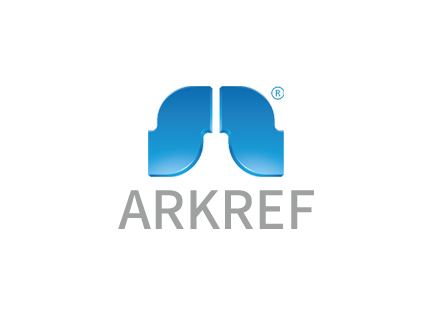How a Display Walk In Cooler Keeps Products Fresh
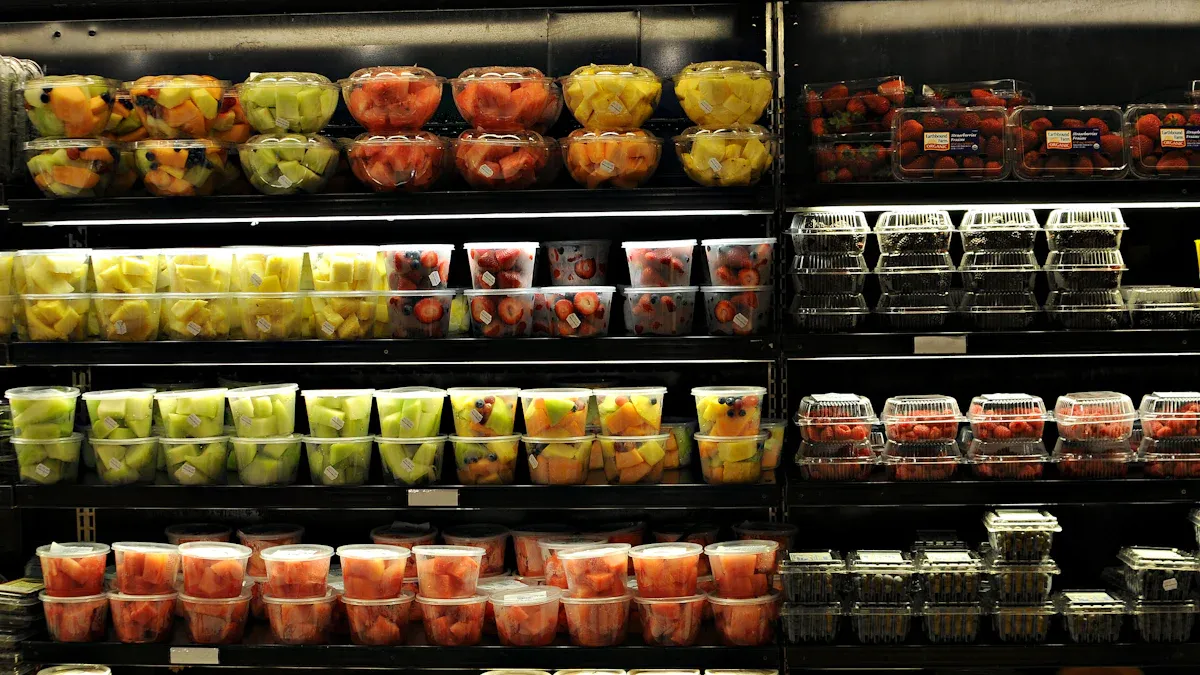
A display walk in cooler helps keep food fresh and easy to see. It keeps the temperature cold and steady. This stops food from going bad. It also helps you follow FDA and USDA rules. Walk-in cooler insulation uses strong panels and tight seals. These keep out heat and help during power outages. You can use a walk-in cooler to store and show products. This makes it easy to organize and display your items. Taking care of your walk-in cooler keeps food fresh longer. Custom walk-in sizes help fit your space and airflow needs.
Key Takeaways
A display walk-in cooler keeps food fresh. It does this by staying cold between 33°F and 41°F. This cold stops bacteria from growing. It also stops food from spoiling.
Glass doors and bright LED lights help customers see products. They do not need to open the cooler. This saves energy. It also makes it easy to find things.
Strong insulation and tight seals keep cold air inside. This lowers energy costs. It also protects food if the power goes out.
Cleaning the cooler often is important. Checking the temperature, humidity, and refrigeration parts helps too. This keeps the cooler working well. It also keeps food safe.
Adjustable shelves and digital monitoring systems help organize food. They stop waste. They also help follow food safety rules.
Display Walk In Cooler Basics
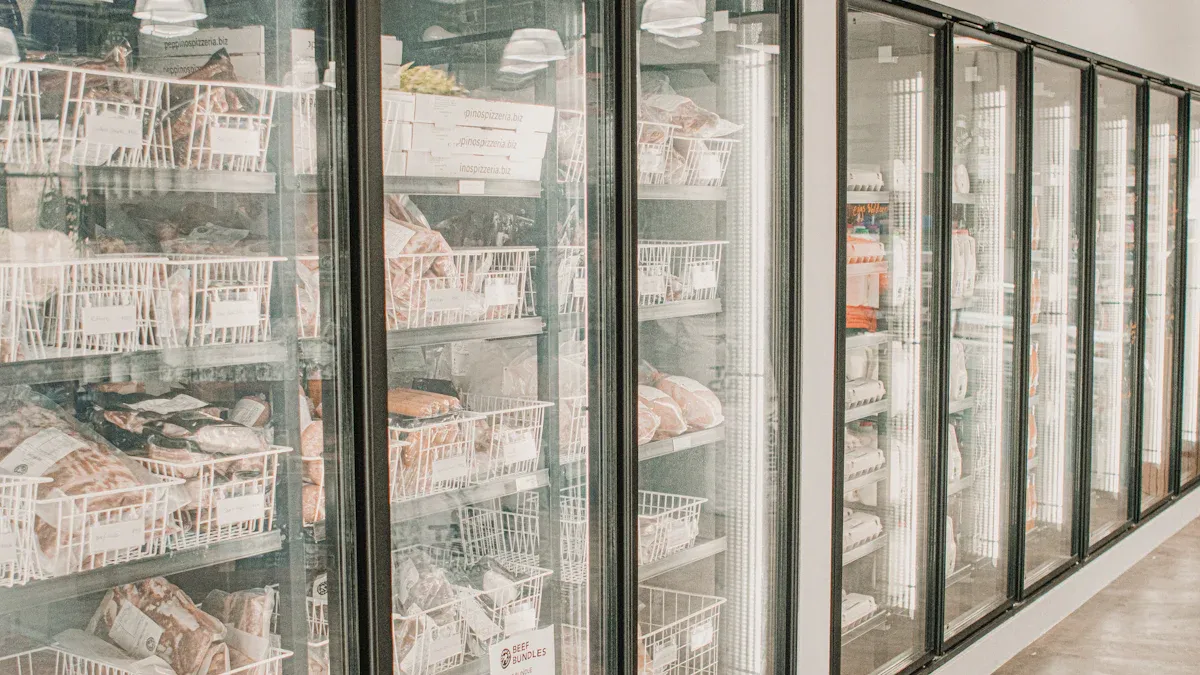
What Is a Display Walk In Cooler
A display walk in cooler is a large, temperature-controlled room that stores and shows perishable products. You often see these coolers in grocery stores, supermarkets, and restaurants. The front of the walk-in cooler usually has glass doors or panels. These clear doors let you and your customers see the products inside without opening the cooler. This design helps you keep food visible and easy to access.
You can walk into the cooler to organize or restock items. The walk-in unit gives you plenty of space to store bulk products like meats, dairy, and produce. The glass doors on the display cooler make it simple for customers to find what they need. You can also use the walk-in cooler to keep products at the right temperature, which helps prevent spoilage.
Tip: A display walk in cooler combines storage and display in one unit. You get the benefits of a walk-in and a display cooler at the same time.
Main Purpose
The main purpose of a display walk in cooler is to keep your products fresh and safe while making them easy to see. The walk-in cooler keeps the temperature between 32°F and 40°F. This range helps stop bacteria from growing and keeps food safe to eat. You can trust the walk-in unit to protect your inventory and reduce waste.
In a busy kitchen or store, the walk-in cooler supports your daily work. Staff can quickly grab ingredients from the walk-in unit, which saves time and keeps your kitchen running smoothly. The cooler also helps you follow food safety rules by keeping everything cold and organized.
A display cooler does more than just store food. It helps you show off your products in an attractive way. Customers can see fresh produce, drinks, or dairy items through the glass doors. This setup encourages people to buy more because they can see what you offer. The walk-in cooler also gives you flexible storage options. You can adjust shelves or add new products as your needs change.
Here is a quick look at what a display walk in cooler offers:
Feature | Benefit for You |
|---|---|
Glass doors/fronts | Easy product visibility |
Keeps food fresh and safe | |
Easy access | Staff can quickly retrieve items |
Flexible organization | Adjustable shelves and layouts |
You can rely on the walk-in cooler to keep your products fresh, safe, and ready for customers. The walk-in unit supports both your storage needs and your sales goals.
How It Works
Walk-In Cooler Refrigeration
You count on a walk-in cooler to keep products safe and fresh. The walk-in refrigeration system has a few main parts. First, the compressor pushes refrigerant through the system. The refrigerant goes to the condenser and lets out heat. Then, the cooled refrigerant moves to the evaporator coils inside. Fans blow air over these coils to cool the air. This makes the temperature drop and keeps it steady.
Walk-in refrigeration works best when all parts work well together. The compressor, evaporator, and fans must all do their jobs. If one part stops working, the temperature can rise fast. You should check the walk-in refrigeration system often. Regular care helps stop problems and keeps your walk-in cooler cold.
Note: A walk-in refrigeration system that is cared for protects your inventory and saves money by stopping spoilage.
Airflow and Temperature
Airflow design is important for keeping your walk-in cooler cold. When you set up your walk-in, place the refrigeration units to move air everywhere. This helps the temperature stay the same in every spot. If airflow is bad, some places may get too warm or too cold. This can make food spoil or freeze.
Installers use special walk-in refrigeration units that push air two ways. For example, the Bohn Model BTO09AG Twin Flow unit cooler pulls air in and blows it out both sides. This keeps the temperature steady and cuts down air loss when you open the doors. It also helps stop products from drying out. You get more even box temperatures, so your products stay fresh longer.
The temperature range in a walk-in cooler is very important. You must keep it between 33°F and 41°F to follow food safety rules. If it goes above 41°F, you could break food safety rules. The table below shows common temperature ranges for walk-in coolers and what foods are stored at each range:
Temperature Range (°F) | Examples of Food Items / Cooler Types | Notes |
|---|---|---|
33 - 35 | Salmon walk-in, dairy walk-in, walk-in cooler | Typical low range temperatures recorded during inspections |
36 - 40 | Display fridges, prep line coolers, cold hold for chicken, ham, turkey, eggs, spinach, tuna salad | Common operating range with no violations noted |
39 - 41 | Cut lettuce, sliced tomatoes, coleslaw, cheese, meat, produce, prep cold hold, tartar sauce on ice | Upper limit for safe cold holding; TCS foods must be at or below 41°F |
Above 41 | Tofu at 50°F, 2-door unit 45-53°F, fish at 46-49°F, ham and roast beef at 49°F | Violations noted; corrective actions required to maintain ≤41°F |
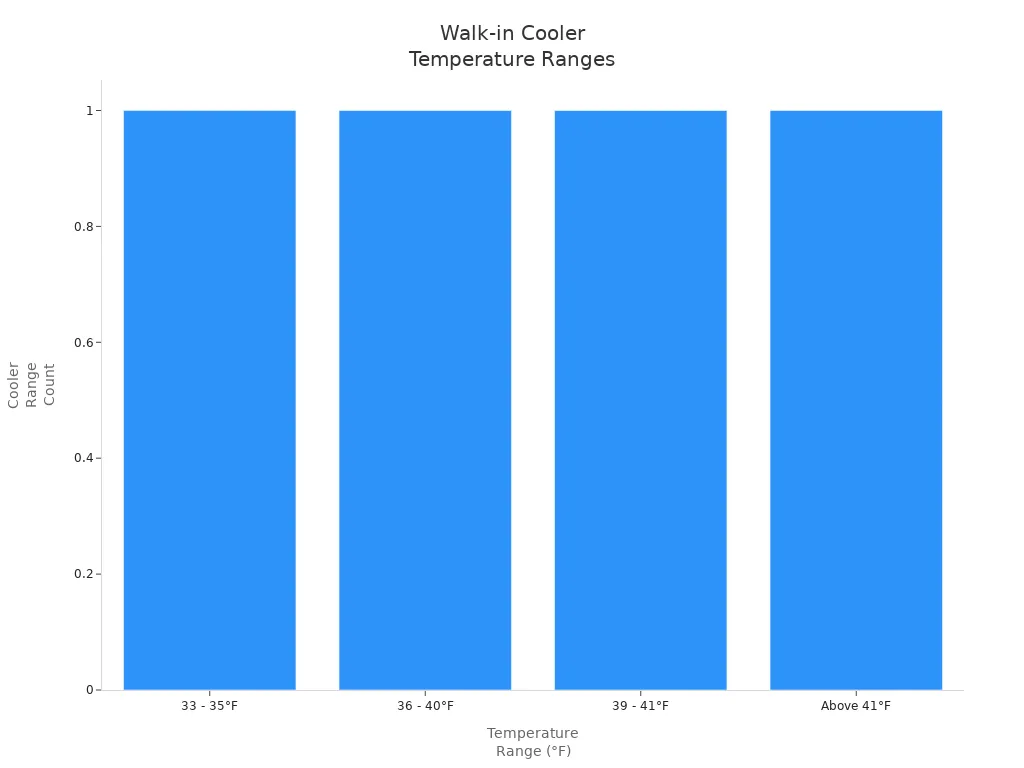
You should always check the temperature in your walk-in cooler. Use a thermometer or a digital monitor. This helps you find problems early and keep products safe.
Humidity Control
Humidity control is also important in walk-in refrigeration. If the air gets too dry, produce and meats can lose moisture and freshness. If humidity is too high, mold or bacteria can grow. The walk-in cooler uses fans and evaporator coils to control humidity. The fans move air, and the coils take out extra moisture.
You can change the humidity in your walk-in cooler by using the controls on your walk-in refrigeration system. Some walk-in units have special humidity controls. These help you keep the right balance for your products. For example, leafy greens need more humidity, but dairy does better with less.
Tip: Check the humidity in your walk-in cooler often. Use a hygrometer to measure it. This helps you keep products fresh and safe.
A walk-in cooler with good refrigeration, airflow, temperature, and humidity control works best. You protect your inventory, save money, and keep customers happy.
Key Features
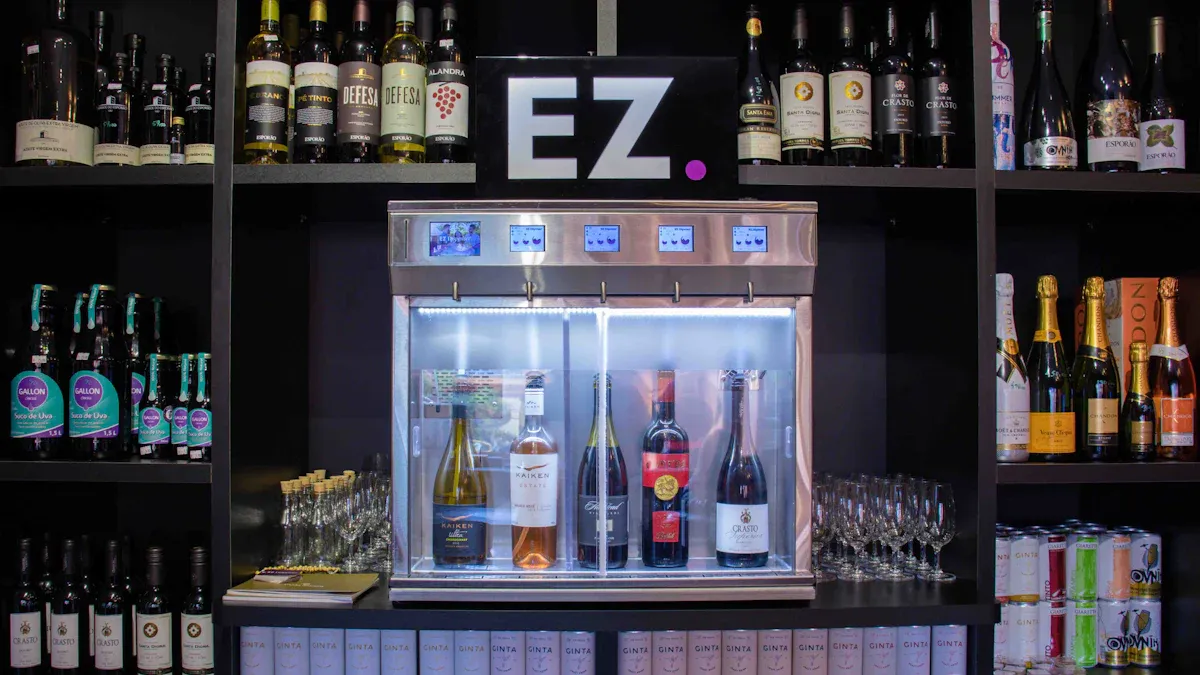
Insulation and Energy Efficiency
Strong insulation is important for your walk-in cooler. High-density panels, such as R-32, keep cold air inside. These panels help the cooler stay cold, even with the doors open. Thick insulation in the walls and floors saves energy. It helps your walk-in cooler work well every day. Self-closing doors with tight seals stop warm air from getting in. This saves you money on energy bills. It also keeps your products safe from spoilage. Energy-efficient walk-in refrigeration systems help keep the temperature steady and low.
Tip: Pick a walk-in cooler with NSF listing for food safety and energy savings.
Glass Doors and Lighting
Glass doors let people see products without opening the walk-in. This keeps the temperature steady and saves energy. Bright LED lights inside the walk-in cooler make items easy to see. You can show drinks, dairy, or produce in a nice way. Glass panels help you check stock levels fast. Some walk-in coolers have two sections for different products or temperatures.
Shelving and Organization
Shelving helps you organize products for easy access. Adjustable shelves fit both big and small items. You can keep meats, dairy, and produce in their own spots. Good organization stops cross-contamination and makes cleaning easy. Use coated shelves to stop rust and keep things looking clean. A neat walk-in freezer or cooler saves your staff time.
Monitoring Systems
Modern walk-in coolers use digital monitoring systems to keep products safe. These systems check temperature and refrigeration all day and night. You get alerts by text or email if it gets too warm or cold. Cloud logs save all temperature data for easy checks. Predictive technology warns you about problems before they happen. Wireless sensors work in any walk-in freezer or cooler, even during power outages. Regular care, like cleaning coils and checking seals, keeps your walk-in cooler and walk-in freezer working well.
Benefits and Uses
Product Freshness
You count on a walk-in cooler to keep food safe and fresh. The walk-in uses thick insulation and steady cold air to stop spoilage. It keeps the temperature between 33°F and 41°F. This stops bacteria from growing on your food. You can keep meats, dairy, and produce in the walk-in for a long time. The walk-in freezer works with the cooler to keep frozen foods cold, down to -18°C. This helps you waste less food and keeps customers happy.
The walk-in cooler has digital controls to check temperature and humidity. You get alerts if the temperature changes, so you can fix it fast. The walk-in freezer has backup systems for power outages. LED lights and glass doors help you see food without opening the cooler. This saves time and keeps food safe.
Tip: A modern walk-in cooler with energy-saving parts can cut your energy use in half. You can save over $300 each year by picking coolers with good insulation, LED lights, and smart airflow.
Common Applications
You see walk-in coolers and walk-in freezers in many places. These units are important in:
Supermarkets and grocery stores
Catering for big parties and events
Food brands and special shops
Cafes, delis, and small stores
The walk-in cooler lets you store lots of food and drinks. In catering, you use the walk-in to get dishes ready before an event. The walk-in freezer keeps desserts and frozen foods ready to serve. Food brands use walk-in coolers to keep products cold for delivery.
In stores, the walk-in cooler helps you sell more. Glass doors and LED lights make snacks and drinks easy to see. You can put the walk-in cooler near checkout to get more impulse buys. Adjustable shelves let you show off products in a nice way. The walk-in freezer and cooler help you follow rules and keep your brand strong.
Cooler Type | Energy Use (kWh/year) | Annual Cost ($) | Estimated Savings ($/year) |
|---|---|---|---|
Standard Cooler | ~5,000 | ~$600 | N/A |
Modern Walk-In Cooler | ~2,500 | ~$300 | $300+ |
You can see that a modern walk-in cooler or walk-in freezer keeps food fresh, saves money, and helps your business.
A display walk in cooler keeps food fresh and easy to see. You get strong insulation and glass doors that save energy. Digital monitors help you check the cooler all the time. Cleaning the coils often helps your cooler work well and keeps food safe. If you buy from a trusted company, you get a warranty and less downtime. You can use guides and manuals if you want to upgrade your cooler. Expert help is also available. Picking the right walk-in cooler saves money, helps your business run better, and keeps products fresh.
FAQ
How often should you clean your display walk-in cooler?
You should clean your walk-in cooler at least once a month. Wipe down shelves, doors, and floors. Check for spills or spoiled food every week. Clean coils and fans every three months for best performance.
What temperature should you set for your walk-in cooler?
Set your walk-in cooler between 33°F and 41°F. This range keeps food safe and fresh. Use a thermometer or digital monitor to check the temperature daily.
Can you store different types of food together in a walk-in cooler?
You can store different foods, but keep raw meats, dairy, and produce on separate shelves. Use labels and organize items to prevent cross-contamination. Adjustable shelves help you keep everything in order.
How do you know if your walk-in cooler is energy efficient?
Look for thick insulation, LED lighting, and self-closing doors. Energy-efficient models use less power and save you money. Check for an NSF listing or ENERGY STAR label.
What should you do if your walk-in cooler stops cooling?
Tip: First, check the power supply and temperature settings. Make sure the doors close tightly. If the cooler still does not cool, call a professional for repairs right away.
See Also
Top Strategies To Maximize Walk-In Chiller Performance
A Step-By-Step Guide To Choosing The Best Cold Room
The Importance Of Cold Rooms For Maintaining Freshness
